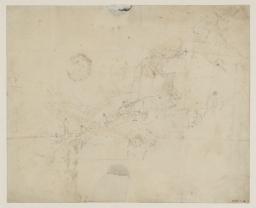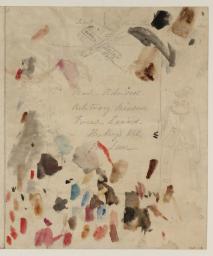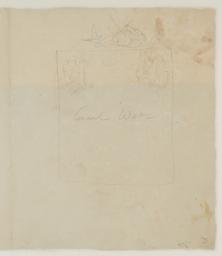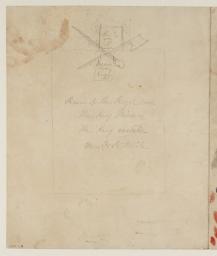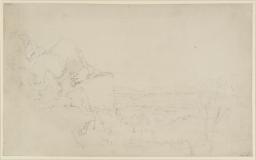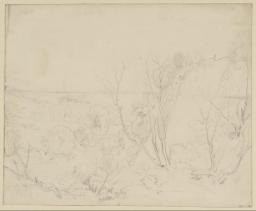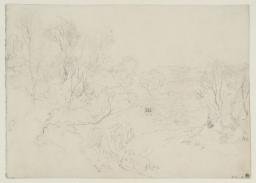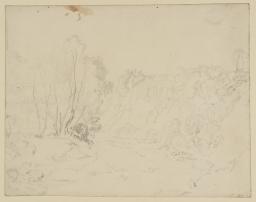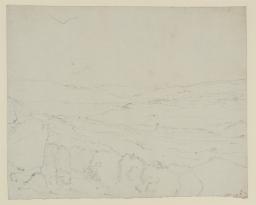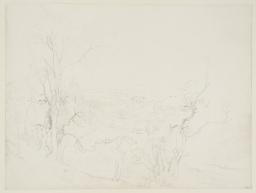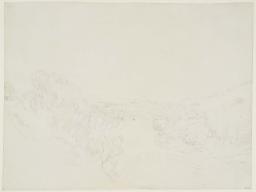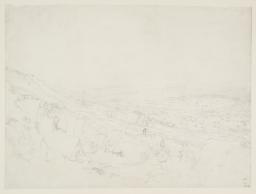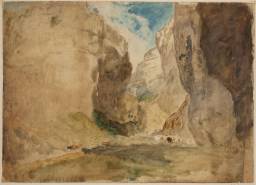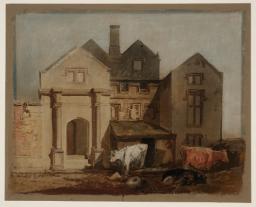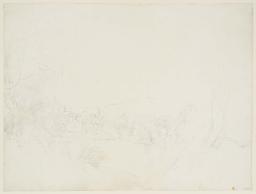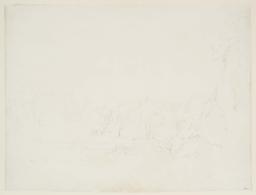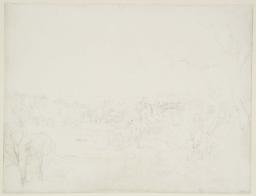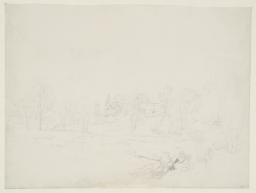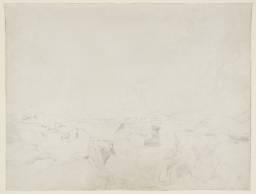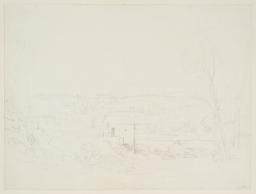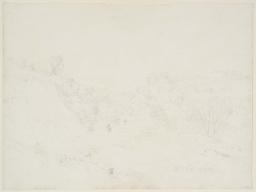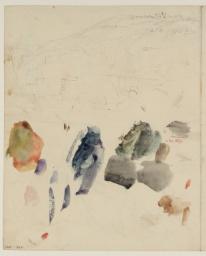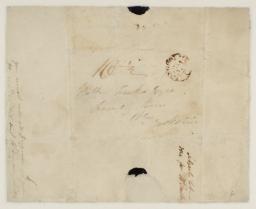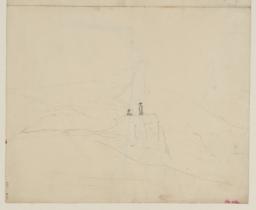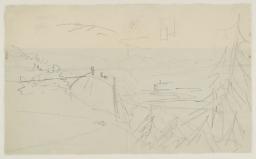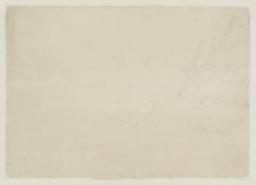Turner Bequest CLIV A–J, L Xa–c
Accepted by the nation as part of the Turner Bequest 1856
References
This section comprises a miscellany of loose folios grouped together by Finberg on the basis of their all having some connection with Farnley Hall, the Yorkshire home of Turner’s friend and patron Walter Fawkes.1
Ten large pencil drawings (D12110, D12111, D12113, D12115, D12116, D12117, D12118, D12119, D12120, D12121; Turner Bequest CLIV L, M, N, Q, R, S, T, U, V, W) form a coherent group, having been made in the Wharfe and Washburn Valleys near Farnley and recording a tour up the River Wharfe from Farnley to Bolton Abbey. Several formed the bases of finished watercolours, some of which are datable to 1809. The present author2 has dubbed the group the ‘Wharfedale and Washburn’ sketchbook. Strictly speaking, the drawings do not form a sketchbook but they do appear to have sprung from a single campaign, probably in the summer of 1808 when Turner first visited Farnley Hall.
Four designs, on a single sheet but traditionally numbered individually (D12100–D12103; Turner Bequest CLIV B–E) are four designs of historical subjects connected with a series of drawings made for Fawkes between about 1815 and 1823. Descended from Charles Fairfax, Governor General of the Parliamentary Army during the Civil War, and himself a reforming politician, Fawkes took keen interest in the rise of parliamentary democracy and rule of law in Britain. He collected historical memorabilia, particularly associated with the Civil War, and it would seem that he proposed (or perhaps wrote) a history of the period for which Turner produced historical vignettes, frontispieces and other illustrations.
The remaining sheets in the group, of more diverse character, may be spread across the whole span of Turner’s visits to Farnley from 1808 to 1824. One sheet from Finberg’s original grouping (Tate D12109; Turner Bequest CLIV K) must be omitted altogether since it belongs with Turner’s tour to Scotland of 1831. For further exclusions see below.
Additional material:
Also in the collection, and not by Turner himself and thus not formally included in this catalogue are the following letter and sketch, (D12123 Turner Bequest CLIV Y) which Finberg added to this group on account of Fawkes authorship or connections:
The text of the letter reads:
By tomorrow’s coach I shall send | you a box containing two Pheasants, a | brace of partridges, and a hare, – which | I trust you will receive safe and good. | We have tormented the poor animals | very much lately and now we must give | them a holiday. –
Remember the Wharfdales – every body is | delighted with your Mill – I sit for a | long time before it every day. –
Ever very truly yrs.
W. Fawkes.3
The letter is undated but the implication is that the gift of game is being made at the end of a long shooting season at Farnley, or that the time of year is Christmas. In the 1909 Inventory Finberg identified the ‘Mill’ with a watercolour ‘View of Otley Mills, with the River Wharfe and mill weir’ sold at Christie’s 27 June 1890. This was bought by Sedelmeyer and has remained untraced since. The ‘Wharfedales’ must be a series of watercolours depicting the Farnley area, perhaps those painted for Fawkes about 1808–9, some of which are derived from sketches in this miscellany including one of Addingham Mill (D12111; Turner Bequest CLIV M). Alternatively Fawkes could be referring to the ‘sketches’ in gouache that Turner made for him about 1816–18.4 John Gage hazards a date of autumn 1818. The sense of the letter, however, is one of heightened anticipation that would fit better with the early days of Turner’s engagement with Wharfedale, following his first visit to Farnley Hall in 1808.
On the verso (D40075) is a pencil drawing in a childish hand, perhaps that of a junior member of the Fawkes family, A Country Church ?c.1808 (Finberg 1909, p.438, CLIV Y, ‘Reverse’). The present author has not been able to identify the building, which does not appear to be any of those in the near vicinity of Farnley Hall, such as Otley, Leathley, Fewston, Weston, Denton, Ilkley or Guiseley.
Catalogue details as follows: Part of a Letter from Walter Fawkes of Farnley Hall to Turner ?c.1808; Pen and ink on a lightweight wove paper, 156 x 201 mm, folded four times to form a letter; Watermarked ‘Hook & S[...] | 1803’; Inscribed by Walter Fawkes in ink (see below); Inscribed in pencil ‘CLIV Y’ bottom right; Stamped in brown ‘CLIV Y’ bottom right. The letter was exhibited as follows:Turner at Farnley Hall, Bradford City Art Gallery, October 1965 (49); Watercolours by J.M.W. Turner (1778 [sic] –1851): Lent by the Trustees of the British Museum, Abbot Hall Art Gallery, Kendal, January–March 1971 (1); Turner 1775–1851, Royal Academy, London, November 1974–March 1975 (B135), as c.1815; Turner and Natural History: The Farnley Project, Tate Gallery, London, October 1988–January 1989 (11). also referenced as follows: A.J. Finberg, A Complete Inventory of the Drawings of the Turner Bequest, London 1909, vol.I, p.438, CLIV Y, as ‘Fragment of letter from Mr. Walter Fawkes, of Farnley...’; A.J. Finberg, Turner’s Water-Colours at Farnley Hall, London 1912, p.4; A.J. Finberg, The Life of J.M.W. Turner, R.A. Second Edition, Revised, with a Supplement, by Hilda F. Finberg, revised ed., Oxford 1961, p.228; P.B., Turner at Farnley Hall, exhibition catalogue, Bradford City Art Gallery 1965, no.49; Jack Lindsay, J.M.W. Turner: His Life and Work: A Critical Biography, London 1966, pp.150, 241 (note 21); Watercolours by J.M.W. Turner (1778 [sic] –1851): Lent by the Trustees of the British Museum, Abbot Hall Art Gallery, Kendal, January–March 1971, no.1; Martin Butlin, Andrew Wilton and John Gage, Turner 1775–1851, exhibition catalogue, Royal Academy, London 1974, pp.191–2 no. B135, where dated c.1815; John Gage, Collected Correspondence of J.M.W. Turner with an Early Diary and a Memoir by George Jones, Oxford 1980, pp.75–6 no.79; Anne Lyles, Turner and Natural History: The Farnley Project, exhibition catalogue, Tate Gallery, London 1988, p.50 no.11; Peter Bower, Turner’s Papers: A Study of the Manufacture, Selection and Use of his Drawing Papers 1787–1820, exhibition catalogue, Tate Gallery, London 1990, pp.90, 93 (note 4); Charles Nugent and Melva Croal, Turner Watercolors from Manchester, exhibition catalogue, Memphis Brooks Museum of Art, Memphis 1997, no.30
How to cite
David Hill, ‘Farnley and Related Subjects c.1808–24’, subset, July 2009, revised by David Blayney Brown, June 2013, in David Blayney Brown (ed.), J.M.W. Turner: Sketchbooks, Drawings and Watercolours, Tate Research Publication, September 2014, https://www

